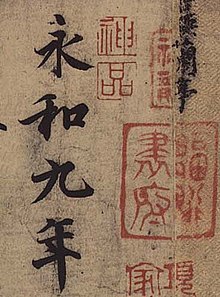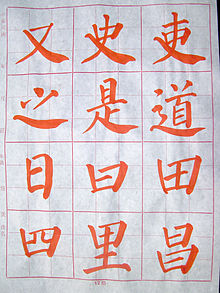Chinese calligraphy
Chinese calligraphy (Chinese 中國書法 / 中国书法, pinyin zhōngguó shūfǎ) is an art form closely related to Chinese painting. The same tools, the Four Treasures of the Scholar's Room, are used in both arts: Writing brush, rod ink, rubbing stone and paper. Therefore, it is not surprising that famous Chinese calligraphers were often also important painters.
One of the most famous Chinese calligraphers was Wang Xizhi, whose style, after more than a millennium, is still the basis of calligraphy instruction today. Calligraphy was considered an important part of education and was also supposed to allow conclusions about personality. Wáng Xīzhī replaced the rectangular ductus with cursive lines, which allowed for individual design. Since then, calligraphy was considered the fourth of the classical arts (四藝 / 四艺, sìyì) in China, along with Wéiqíl - also known as Go, painting and music - also known in Chinese as - Qín, Qí, Shū, Huà; 琴棋書畫 / 琴棋书画 - "Guqin, Weiqi, Calligraphy, Painting", .
The high prestige of calligraphy is reflected, among other things, in the fact that even Chinese emperors endeavored to excel in calligraphy. The emperor Song Huizong, whose style of slender gold (瘦金, shòujīn) is a high point of Chinese calligraphy, made the most progress in this art.
The basis of Chinese calligraphy is the "Eight Principles of the Character Yǒng" - 永 'Yǒng means "eternity"' - (永字八法, Yǒngzì Bāfǎ):
側 (侧) cè, namely 點 (点) diǎn, dot
勒 lè, namely 橫 (横) héng, trans.
努 nǔ, namely 直/豎 (竖) zhí/shù, straight ahead.
趯 tì, namely 鉤 (钩) gōu, hook
策 cè, namely 挑 tiāo, take-off
掠 lüè, namely 撇 piě, oblique
啄 zhuó, namely 短撇 duǎn piě, pecking.
磔 zhé, viz. 捺 nà, pressing forward
· The eight principles of the sign Yǒng - 永
· 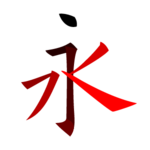
Character 永 - Yǒng
· 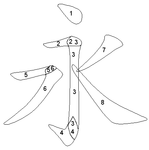
Spelling of the character
· 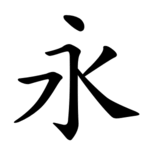
Animated 永 - Yǒng character
· 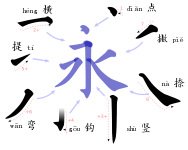
Eight calligraphic parts of the Yǒng - 永
The eight principles represent the most important basic strokes of the calligrapher; they describe the five strokes that make up the character.
The first four characters of Wang Xizhi's Orchid Pavilion: "In the 9th year of Yonghe's government".
Calligraphy exercise
Categories of Chinese calligraphy
| Chinese calligraphy categories | |||||||||
| German | Alternative | Langz. | Shortz. | Pinyin | Kanji | Hepburn | Hangeul | R.R. | Quốc Ngữ |
| Seal script | - – | 篆書 | 篆书 | Zhuànshū | 篆書 | Tensho | 전서 | Jeonseo | Triện thư |
| Italics | Semi italics | 行書 | 行书 | Xíngshū | 行書 | Gyōsho | 행서 | Haengseo | Hành thư |
| Grass font | Concept font | 草書 | 草书 | Cǎoshū | 草書 | Sōsho | 초서 | Choseo | Thảo thư |
| Kanzleischrift | Official font | 隸書 | 隶书 | Lìshū | 隸書 | Reisho | 예서 | Yeseo | Lệ thư |
| Rules font | Block letters | 楷書 | 楷书 | Kǎishū | 楷書 | Kaisho | 해서 | Haeseo | Khải thư |
· 
Seal script
· 
Semi italics
· 
Grass font
· 
Kanzleischrift
· 
Rules font
See also
- Strokes
- Chinese script
- Calligraphy
- Orchid pavilion
- Japanese calligraphy
Search within the encyclopedia
